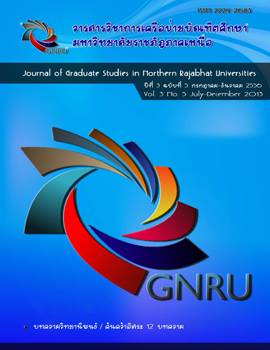แนวทางการพัฒนาทุนทางสังคมของตำรวจภูธรจังหวัดนครสวรรค์
Main Article Content
Abstract
การวิจัยครั้งนี้มีวัตถุประสงค์เพื่อ ศึกษาเพื่อเปรียบเทียบทุนทางสังคมของตำรวจภูธร จำแนกตามสถานภาพส่วนบุคคล และเพื่อนำเสนอแนวทางการพัฒนาทุนทางสังคมของตำรวจภูธรจังหวัดนครสวรรค์ แบ่งการศึกษาเป็น 2 ขั้นตอน ขั้นตอนที่ 1 การศึกษาระดับทุนทางสังคมของตำรวจภูธรจังหวัดนครสวรรค์ กลุ่มตัวอย่างได้แก่ ตำรวจสัญญาบัตร จำนวน 279 คนเครื่องมือที่ใช้ ได้แก่ แบบสอบถามทุนทางสังคมของตำรวจ เป็นแบบประมาณค่า 5 ระดับ มีค่าความเที่ยง 0.82 สถิติที่ใช้ ได้แก่ ค่าเฉลี่ย () ค่าเบี่ยงเบนมาตรฐาน (S.D.) การเปรียบเทียบค่าเฉลี่ย (t-test) และการวิเคราะห์ความแปรปรวนแบบทางเดียว (One Way ANOVA) ขั้นตอนที่ 2 การนำเสนอแนวทางการพัฒนาทุนทางสังคมของตำรวจ จัดประชุมสนทนากลุ่มโดยผู้เชี่ยวชาญ จำนวน 9 คน
ผลการวิจัยพบว่า
1.ระดับทุนทางสังคมของตำรวจภูธรจังหวัดนครสวรรค์ในภาพรวมอยู่ในระดับมาก โดยด้านวัฒนธรรมองค์กรมีระดับทุนทางสังคมสูงสุด ต่ำสุดได้แก่ ด้านประสิทธิภาพและประสิทธิผลในการทำงาน แต่อยู่ในระดับมาก
2. การเปรียบเทียบทุนทางสังคมของตำรวจ จำแนกตามสถานภาพ พบว่า ตำรวจที่จบการศึกษาจากโรงเรียนนายร้อยตำรวจกับจบจากสถาบันอื่น มีระดับทุนทางสังคมไม่แตกต่างกัน อย่างมีนัยสำคัญที่ระดับ .05
3. ตำรวจที่สายปฏิบัติงานต่างกันมีระดับทุนทางสังคมไม่แตกต่างกันอย่างมีนัยสำคัญที่ระดับ .05
4. ตำรวจที่มีภูมิลำเนาอยู่ในจังหวัดนครสวรรค์กับภูมิลำเนาจังหวัดอื่น มีระดับทุนทางสังคมแตกต่างกัน อย่างมีนัยสำคัญที่ระดับ .05
5. แนวทางการพัฒนาทุนทางสังคมของตำรวจประกอบด้วย 6 ด้านได้แก่ ด้านเครือข่ายทางสังคม ด้านความรับผิดชอบ ด้านความไว้วางใจ ด้านวัฒนธรรมองค์กร ด้านการสื่อสาร และด้านประสิทธิภาพและประสิทธิผลในการทำงาน
Abstract
The objectives of this research were, 1) to study the social capital level of NakhonSawan Provincial Police, 2) to compare the Social Capital of Nakhon Sawan Provincial Police which categorized in terms of personal status, and 3) to propose the development of social capital of Nakhon Sawan Provincial Police. The research consisted of two phases; first was the study of social capital level by using questionnaires (5-level Likert Scale) with reliability coefficient of 0.82. Mean, Standard Deviation (S.D.), t-test, and One Way ANOVA were used for statistical analysis. The second phase was to propose the social capital development guideline by focus group discussion of 9 experts.
The research results are as follows:
1. The social capital of police Nakhon Sawan Provincial Police office at a is high level with the highest ranking in organization culture and the lowest ranking work efficiency and effectiveness
2. The comparative study of social capital by personal status found that the police who graduated from Royal Police Cadet Academy (RPCA) and other institutions have no different level of social capital at the 0.05 level of significance.
3. The police who work in different duties have no difference in social capital level at the 0.05 level of significance.
4. The police who have a place of residence in Nakhon Sawan and other provinces have different level of social capital at the 0.05 level of significance.
5. The social capital development guideline consisted of 6 elements which are social network, responsibility, reliability, organizational culture, communication, work efficiency and effectiveness.


